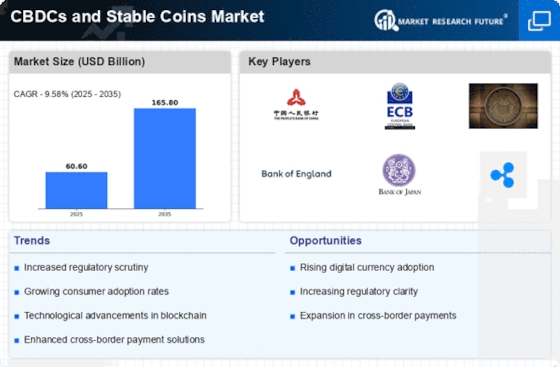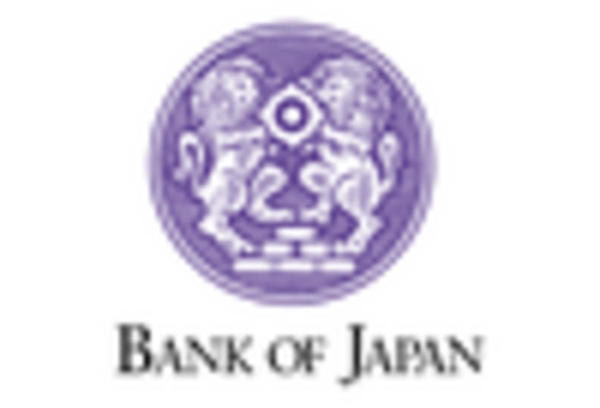Consumer Awareness and Education
Consumer awareness and education are vital drivers for the CBDCs and Stable Coins Market. As individuals become more informed about the benefits and functionalities of digital currencies, their willingness to adopt these innovations increases. Educational initiatives by governments, financial institutions, and industry players are crucial in demystifying CBDCs and stable coins. Surveys indicate that a significant portion of the population remains unaware of how these digital currencies operate, which presents an opportunity for targeted educational campaigns. By enhancing understanding, stakeholders can alleviate concerns regarding security and volatility, thereby fostering a more favorable perception of CBDCs and stable coins. This increased awareness is likely to translate into higher adoption rates, further propelling the growth of the CBDCs and Stable Coins Market.
Regulatory Support and Frameworks
Regulatory developments play a crucial role in shaping the CBDCs and Stable Coins Market. Governments and financial authorities are increasingly recognizing the potential benefits of digital currencies, leading to the establishment of supportive regulatory frameworks. For instance, several countries have initiated pilot programs for CBDCs, aiming to explore their implications on monetary policy and financial stability. The establishment of clear regulations can enhance consumer confidence, encouraging wider adoption of CBDCs and stable coins. Moreover, as regulatory clarity improves, it may attract institutional investors, further bolstering the market. The proactive stance of regulators in addressing concerns related to security, privacy, and anti-money laundering measures is likely to foster a conducive environment for the growth of the CBDCs and Stable Coins Market.
Increased Demand for Digital Payments
The rise in demand for digital payment solutions is a pivotal driver for the CBDCs and Stable Coins Market. As consumers and businesses increasingly prefer cashless transactions, the need for secure and efficient digital currencies has surged. According to recent data, the digital payment market is projected to reach a value of over 10 trillion USD by 2026. This trend indicates a growing acceptance of digital currencies, including CBDCs and stable coins, as viable alternatives to traditional payment methods. The convenience and speed offered by these digital currencies are likely to enhance their adoption, thereby propelling the CBDCs and Stable Coins Market forward. Furthermore, the integration of these currencies into existing financial systems may facilitate smoother transactions, attracting more users and businesses to embrace this evolving financial landscape.
Technological Innovations in Blockchain
Technological advancements, particularly in blockchain technology, are significantly influencing the CBDCs and Stable Coins Market. Innovations such as smart contracts, scalability solutions, and interoperability are enhancing the functionality and efficiency of digital currencies. For example, the implementation of layer-2 solutions is enabling faster transaction processing, which is essential for the widespread adoption of CBDCs and stable coins. Additionally, the integration of decentralized finance (DeFi) protocols with stable coins is creating new opportunities for users to engage in lending, borrowing, and trading. As these technologies continue to evolve, they are likely to address existing challenges in the CBDCs and Stable Coins Market, making digital currencies more appealing to a broader audience. The ongoing research and development in this field suggest a promising future for the integration of advanced technologies in digital currency systems.
Global Economic Shifts and Financial Inclusion
Economic shifts and the pursuit of financial inclusion are emerging as key drivers for the CBDCs and Stable Coins Market. As economies evolve, there is a growing recognition of the need to provide accessible financial services to underserved populations. CBDCs and stable coins offer a potential solution by enabling low-cost transactions and reducing barriers to entry for individuals without traditional banking access. Reports suggest that nearly 1.7 billion adults remain unbanked, highlighting a significant market opportunity for digital currencies. By facilitating financial inclusion, these digital currencies can stimulate economic activity and empower individuals, thereby contributing to the overall growth of the CBDCs and Stable Coins Market. The alignment of economic goals with the capabilities of digital currencies may lead to innovative solutions that address long-standing financial disparities.


















Leave a Comment